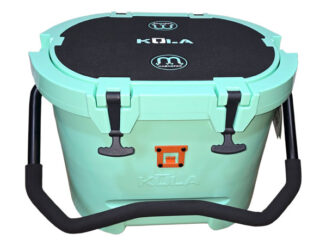
Drop whatever you’re doing, and head to the mouth of the Mississippi River this month, where giant schools of mullet bring monstrous yellowfin tuna as close to the coast as they’ll ever be.
October begins the best yellowfin tuna fishing of the year — as close as 5 miles south of South Pass. Big tuna move in to feast on the schools of spawning mullet as they migrate into the Gulf of Mexico. Louisiana’s shallow coastline and substantial river systems often force offshore anglers to travel 50 to 60 miles to find the steamrolling pelagics they desire.
In the fall, all that changes. The tuna move into an area of the Gulf from 5 to 20 miles out of South Pass.
“For the most part, the tuna are all in a 10-mile radius between the 7-mile rigs and the Elf,” said Venice guide Capt. Shane Frazier.
When the weather cooperates, October and November tuna fishing is second to none.
“(In October 2004), we fished a massive school of tuna that was feeding on mullet for hours. The tuna never moved away from the mullet, and we were 2 miles away from any of the rigs,” Frazier said.
As long as the river stays low, the yellowfin tuna will move in close to the coast in search of schools of mullet and small hardtails, which Frazier calls “tuna crack.” They can hold the pattern for weeks if the weather remains favorable.
By the end of October 2004, the river stage was 3.3 feet, water temperatures hovered at 80 degrees, the tuna had moved in to 14 miles off the mouth of South Pass, and anglers were rejoicing.
Venice Capt. Eddie Burger said dropping surface water temperatures can push the tuna action to downright explosive, heralding in some of the easiest tuna catches of the year.
“The later in the year, the more surface action we see until the water temperatures drop below 70, and then they move to the Lump,” he explained.
After water temperatures drop into the 60s, the yellowfin will move to the Lump, which is an uprising in the Gulf of Mexico 14 miles out of Southwest Pass. There they will remain until March.
But until then, tuna will remain on the surface for longer and longer periods of time.
“They don’t have to dive down to cool off like they do in the summer months,” Burger said.
The caveat for fishing in the fall is the conditions must behave. Those conditions include: a river of 5 feet or below, water temperatures above 69, and southerly breezes to keep the blue water close in. Find the mullet under these conditions, and you’ll find the tuna, Frazier said.
According to Capt. Brent Ballay, beginning with the first full moon in October (Oct. 7 this year) and lasting through two or three cycles, the mullet move into the Gulf to spawn. There they form huge schools — sometimes the size of football fields — that attract hungry tuna.
Imagine only 5 miles of open Gulf between the adventure-starved angler and huge thrashing schools of yellowfin tuna. Of course, these pelagics can move from 5 to 50 miles out in one day. Keep informed of the latest tuna coordinates by reading the posted reports on www.lasmag.com.
Burger finds that slow-trolling live baits and casting poppers work best. He prefers to slow-troll both a live mullet on a No. 9 circle hook and small live hardtail on a No. 7 circle at the same time.
“The smaller tuna will hit the hardtail, but the bigger tuna will hit both,” he said.
Both captains will target schools of mullet if they spot them on the upcurrent side of the rigs at this time of year. Sometimes the slow-troll is nothing more than bumping the boat in and out of gear to keep the baits in position and swimming as naturally as possible, Frazier said.
During the trip we took with both captains in October 2004, we had to go 60 miles out to a new rig called the Devil’s Tower to find the fish. While Burger was trolling, we cast Hydro-tiger poppers made by Yo-Zuri off the bow, and caught five small yellowfin. I couldn’t help thinking that these small but feisty fish would have been a fly fisherman’s dream-come-true as eager as they were to take our offerings.
We left these fish still hungry and crashing the surface, and went to a nearby drilling ship called the Discovery Enterprise to find something more photogenic. Burger rigged some baby hardtails we had caught on sabiki rigs at the Elf — a rig located 20 miles south of South Pass.
We could see that the yellowfins were indeed running larger at this rig, and almost immediately after getting our baits in the water, we hooked up with one.
“That’ll be Mr. Tuna to you,” the 75-pound yellowfin seemed to say as he wore out our two oldest sons before finally coming aboard. Then the seas went flat because the current stopped — and so did the fish bite.
“When the current is running, it bunches up the baitfish and the tuna, making them easier to catch,” Burger explained. “When the current stops, the tuna tend to spread out, and it’s hard to get the baits to them.
“Usually, the tuna bite best before 11 or after 4, but they’ll bite all day if it’s cloudy.”
We had to travel 60 miles out in mid-October to find the tuna that were still recovering from Hurricane Ivan. According to Burger and Frazier, the hurricane messed up the fishing for weeks afterward.
In the fall, Frazier likes to leave the dock early.
“If I leave at 5:30, I can beat the fog if there is any,” he said.
From there, it takes Frazier’s 36-foot Twin Vee powered by twin 250 Suzukis only 45 minutes to run where he will start fishing.
“It’s generally not hard to find the mullet,” he said. “I like to cast net for them the night before around the marina. If not, I’ll usually find them in the river at the Jump.
“You must use a special cast net made for mullet with bigger holes and a faster drop in order to catch them.”
But it’s worth the effort.
“With the amount of pressure these fish are under, you need live bait to catch the big tuna,” he said.
Both captains use 80-pound mono with a 5-foot, 80-pound fluorocarbon leader tied together with a blood knot for trolling.
“The bottom-line is you’re gonna get more strikes using a fluorocarbon leader,” Frazier said.
When the action gets close to the boat, they will cast the poppers. For the casting rods, they use 80-pound Power Pro with a 3-foot leader of 80-pound mono.
“This time of year, you’re hunting,” he said. “The fish aren’t just around rigs. Five miles out, I start looking for schools of mullet. If I don’t see any mullet, I’ll try to drift fish on the upcurrent side of the rig.”
If he doesn’t see any activity, Frazier will circle the rig with his fish-finder.
“Tuna are fairly easy to mark,” he said. “If I don’t catch any there, I’ll go rig-hopping until I find them.”
The tuna will run anywhere from 20 to 100-plus pounds. Even though we had to go 60 miles out on our trip, we saw lots of action, and our kids had a blast.
We may even try to take our 23-foot Ranger down to Venice this month if the tuna move in close enough.
Call Capt. Eddie Burger at 985-788-5080 or Capt. Shane Frazier at 504-416-0457.


